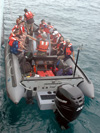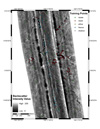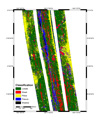Photo & Video Log
This page contains photos and videos taken during the
GalAPAGoS: Where Ridge Meets Hotspot expedition
that took place December 3 - January 10 2006. Click on any image to view
a larger version and for additional information. If a movie camera icon
![]() is
present, a QuickTime video can be viewed by clicking on the image. Other
video formats are available on the linked pages.
is
present, a QuickTime video can be viewed by clicking on the image. Other
video formats are available on the linked pages.
If a slideshow icon ![]() is
present, a visual log of exploration images can be viewed. You can scroll
through them one by one, or select the play button for an automatic slideshow.
is
present, a visual log of exploration images can be viewed. You can scroll
through them one by one, or select the play button for an automatic slideshow.
(HR) = "High Resolution" images available.
 Video & Slideshows
Video & Slideshows
![]() January 3
January 3
Chimney morphology varies widely and evolves as chimneys grow and become more complex over time.
![]() December 29
December 29
Dense communities of giant tubeworms thriving in a chemosynthetic environment fueled by billowing black smokers.
Images
January 10
Team members of the GalAPAGoS expedition pose for a group shot on the RV Thompson's 03 deck. (HR)
January 5
Sonar Data Systems Specialist, Akel Stirling, edits processed phase bathymetry data collected by the DSL120. (HR)
January 5
Chemical Oceanographer Joe Resing, compiles data collected by this in situ chemical analyzer. (HR)
January 5
Co-PI, Scott White, and Chief Scientist, Rachel Haymon, look at one of the higher resolution bathymetric maps.
January 3
Hydrothermal vents begin to form beneath the seafloor where superheated water flows through cracks in the earth's crust. (HR)
January 3
Over time, the height, width and thickness of a chimney structure builds around the vent flow. (HR)
January 1
The first photograph of a black smoker vent published on the cover of Science magazine. (HR)
December 29
Densities of galatheid crabs and serpulid worms begin to increase as we cross through terrain filled with lava pillows. (HR)
December 29
Dense communities of giant tubeworms thriving in a chemosynthetic environment fueled by billowing black smokers. (HR)
December 28
Sheet, lobate, and pillow lava morphology, the three main morphological flows that are produced by submarine eruptions.
December 28
The chart above displays a section of sidescan sonar data with ground reference lava morphology classifications.
December 28
The same sidescan image that has been converted from processed sidescan data to be classified by lava morphology type.
December 26
The common way to supply electricity to the armature (the part that rotates) of the motor is through a series of carbon brushes.
December 26
RV Thompson has two 3000 horse power, DC electric motors, each run by 750 volts or 3150 amps of electricity. (HR)
December 26
The WHOI Dynacon winch is fitted for DSL operations and has a hydraulic level wind. (HR)
December 25
Co-Principal Investigator Edward Baker poses in front the ship's fireplace and Christmas tree. (HR)
December 25
Acoustic technicians, Jamie Smith and Jennie Morgan, bake sugar and gingerbread cookies for the holidays. (HR)
December 24
Able-bodied seaman Brian Clampitt has been working at sea for 25 years, spending many holidays away from home. (HR)
December 24
During major holidays, crews at sea will typically celebrate with a special meal, a day of light duty, or a BBQ on deck. (HR)
December 22
The steel frame of the DSL120 can create changes in the magnetic field measured by the magnetometer. (HR)
December 20
The screen grab above displays the first step in the sidescan sonar editing process. (HR)
December 20
Once all variables are merged with the processed sound data, the complete dataset is georeferenced. (HR)
December 18
Monica Heintz and Christine Desautels work with research technician Nathan Buck to extract water samples.
December 16
Head Cook, Ray Gideons, washes lettuce for the full salad bar that accompanies lunch and dinner on board.
December 16
The RV Thompson's small boat approaches the vessel loaded with fresh fruits from port. (HR)
December 14
The calcium carbonate shells of tiny sea creatures living at the sea surface fall to the seafloor. (HR)
December 14
The lava flows in the photo above are young, because they show little accumulation of sediment. (HR)
December 13
After an initial deployment to the seafloor, the Medea is brought back on deck to replace a malfunctioning altimeter. (HR)
December 10
Hot waters emanating from hydrothermal vents are less dense than seawater and rise up above the volcano.
December 8
The Miniature Autonomous Plume Recorder is a self-contained instrument for recording temperature, pressure and optical data. (HR)
December 8
Data streamed in real-time from sensors on board the DSL120 are displayed on a monitor in the control van.
December 6
A red warning appears on the DSL topside GUI monitor, alerting technicians of a "ground" or power failure in the system.
December 6
CTD and Niskin bottles are lowered over previously identified hydrothermal plume sites to collect additional data. (HR)
December 6
DSL technicians and scientists monitor incoming data and information from the sonar sled in the DSL van. (HR)
December 5
Watchstanders monitored the incoming EM300 raw multibeam data for quality continuously in shifts of 4 hours on/8 hours off. (HR)
December 3
The R/V Thomas G. Thompson, measuring 274 ft in length and operating with a crew of 22. (HR)
December 3
Chemical Oceanographer, Joe Resing, prepares a hydrothermal plume sensor for deployment. (HR)




























































































